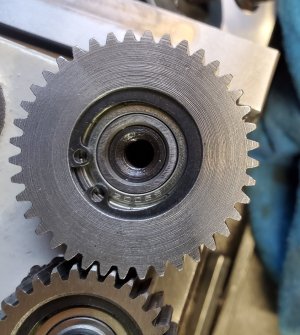DPittman
Ultra Member
I've cut a few brass and nylon gears but had never cut a steel one until now.
I recently noticed one of the gears in my reverse tumbler mechanism on my lathe had several chipped teeth. I'm pretty sure that was caused by a dumb head operator move engaging the gears while rotating. I had noticed the gears were noisier than normal but I kind of ignored that.
I'm always a bit nervous when getting near full circle cutting when I'm sure the last few teeth are not going to fit. And then I am surprised when the last tooth gets cut perfectly.
Question for the more experienced gear cutters.... do I use the same cutter rpm calculation for determining correct cutter speed based on the gear cutter diameter just the same as an end mill? My gear cutter is 2" diameter and I ran it at about 175 rpm. Steel material is the same as I often use....who knows mystery salvage steel.


I recently noticed one of the gears in my reverse tumbler mechanism on my lathe had several chipped teeth. I'm pretty sure that was caused by a dumb head operator move engaging the gears while rotating. I had noticed the gears were noisier than normal but I kind of ignored that.
I'm always a bit nervous when getting near full circle cutting when I'm sure the last few teeth are not going to fit. And then I am surprised when the last tooth gets cut perfectly.
Question for the more experienced gear cutters.... do I use the same cutter rpm calculation for determining correct cutter speed based on the gear cutter diameter just the same as an end mill? My gear cutter is 2" diameter and I ran it at about 175 rpm. Steel material is the same as I often use....who knows mystery salvage steel.

